Mtg Lands That Produce Green or Blue Mana
Last updated on May 25, 2022
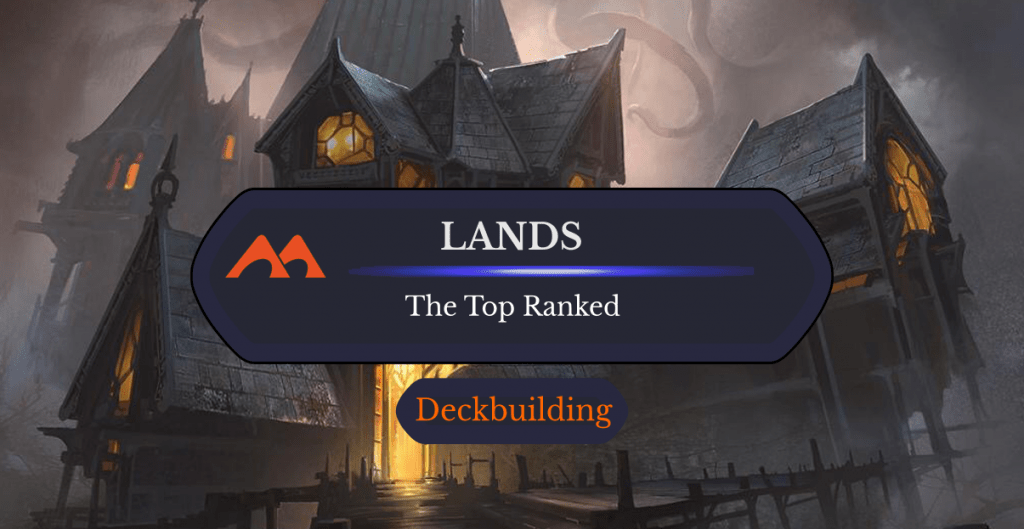
Geier Reach Sanitarium | Illustration by Cliff Childs
There are some incredibly powerful lands that can warp whole formats, even if they don't quite reach the pinnacle of Magic power level. These lands act as the foundation for every format from Vintage to Commander and are what I'll be looking at today.
These lands were all over the place or broken in their efficiency or abilities at some point. But what are the best lands in all of Magic? I'll start with cycles of dual lands and then break down the best lands in each color before moving to the best utility and legendary lands.
Ready? Let's jump right in!
What Makes the Best Land?
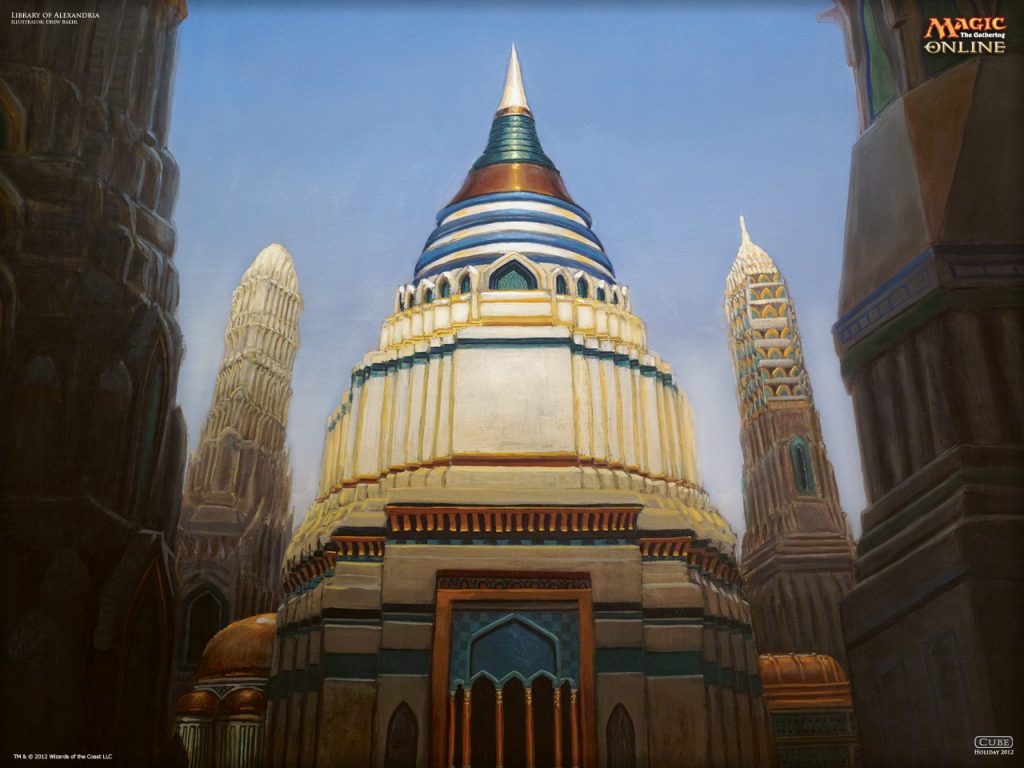
Library of Alexandria | Illustration by Drew Baker
Lands that see play across various formats, can single-handedly win or dominate games, and allow value to come from your mana base are all powerful enough to be considered great lands. But how do you decide which are the best of the best?
Some formats are synonymous with specific lands and some decks need a certain land to function. When a land transcends value or power and becomes defining, that makes it one of the best lands in Magic history.
Best Dual Land Cycles
Color-fixing in Magic has long been a staple of all eternal formats. You'll win more games if you can reliably cast all your spells.
As deck designers push the limits of greed pile decks you see 3-, 4-, and 5-color decks maximizing the best spells by having the best mana bases. A major part of these deck's power stems from the flexibility of their dual lands and the lands that find them.
Alpha / Beta Duals
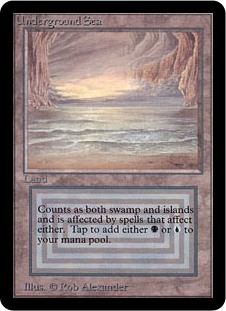
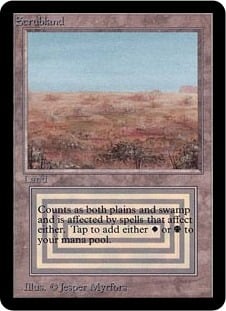
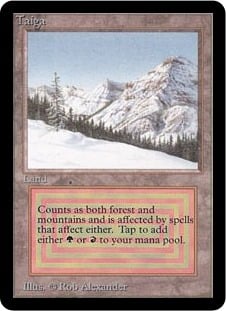
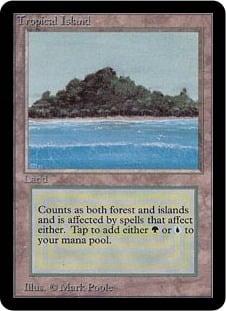
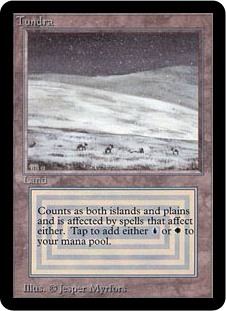

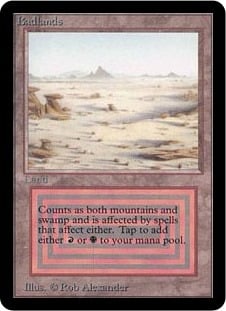
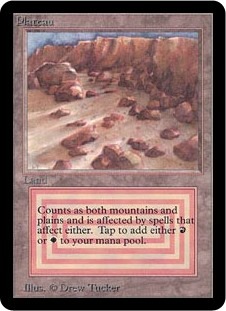
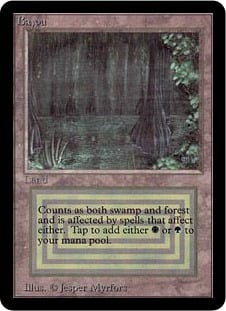
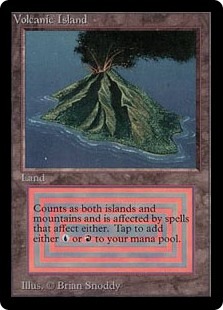
- Underground Sea
- Scrubland
- Taiga
- Tropical Island
- Tundra
- Savannah
- Badlands
- Plateau
- Bayou
- Volcanic Island
The Alpha and Beta dual lands remain the pinnacle of mana fixing to this day. Lands that tap for two colors and come into play with no conditions. They're searchable with any affect that can find non-basics with land types like Forest, Swamp, Island, Mountain, or Plains.
The original duals build the foundation of every format where they're legal. They're also some of the most expensive individual cards in Magic's history. These duals often cost hundreds of dollars for the cheapest versions and upwards of 10k for Alpha versions of Underground Sea.
While it's a fun trivia fact that Alpha only had nine dual lands and Beta saw the printing of Volcanic Island, these ten duals are the foundation of Magic and remain the strongest dual land cycle ever printed.
Fetch Lands
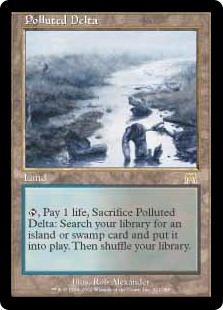
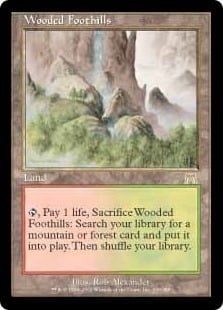

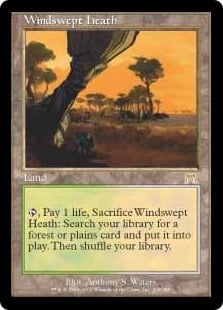
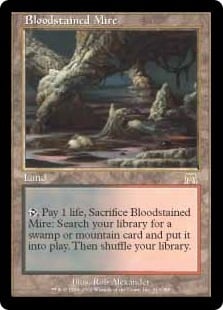
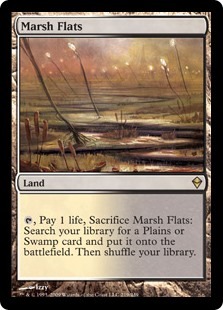
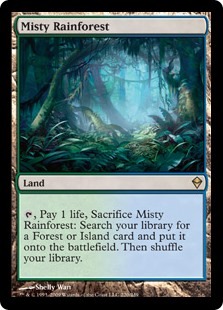
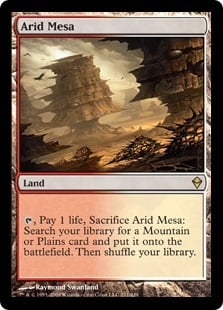
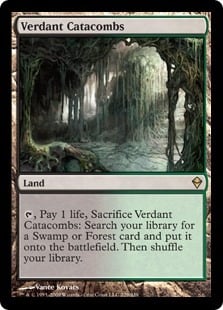
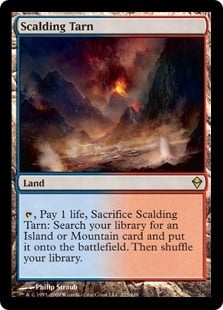
- Polluted Delta
- Wooded Foothills
- Flooded Strand
- Windswept Heath
- Bloodstained Mire
- Marsh Flats
- Misty Rainforest
- Arid Mesa
- Verdant Catacombs
- Scalding Tarn
These ten fetch lands serve as the defining lands of Modern. They're a large part of why dual lands are so powerful in older formats and were powerful enough for a pre-format ban in Pioneer. Having the ability to fix for whatever half of these 2-colored fetches is a powerful effect.
Add to that the fact that land subtypes like Forest are fetchable by four of the ten fetches, you see that four fetch lands can fetch eight unique duals. Your mana capabilities explode compared to having to draw the right colors and this expands the range of cards a deck can play.
While these lands have a slight cost in paying life to activate them, they come with a subtle but powerful additional benefit. In formats that have Brainstorm or Brainstorm effects like Modern, Legacy, Vintage, and Commander, shuffling away unwanted cards is a huge upside to playing fetches. Skilled pilots will keep a fetch or two around on the battlefield to enable a shuffle effect later in the game whenever they find a card that can manipulate the library's order.
A key metric that continues to show up is lands that double as either spells or have a special effect on deckbuilding or play patterns. Fetches are a prime example of lands that can improve whole subsets of cards just by strategically using their text outside of their intended purpose.
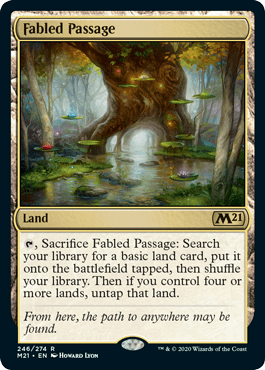
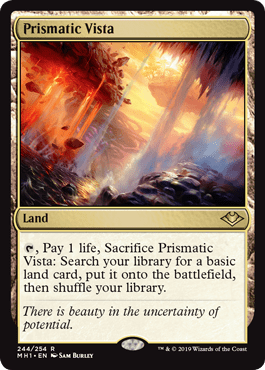
- Fabled Passage
- Prismatic Vista
These two fetches are a little different from the Onslaught and Zendikar lands since they can only fetch basic lands. Passage saw play as an upgraded Evolving Wilds in formats like Standard and Pioneer. In Modern, Legacy, and Vintage, Vista acts as an additional fetch to ensure higher shuffle counts, especially in decks that play an abundance of basics like Miracles.
Having access to more shuffle effects greatly improves the quality of these decks. Not to mention pairing with cards like Omnath, Locus of Creation, which benefits from having multiple lands enter in a single turn.
Shocklands
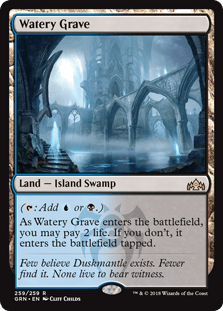
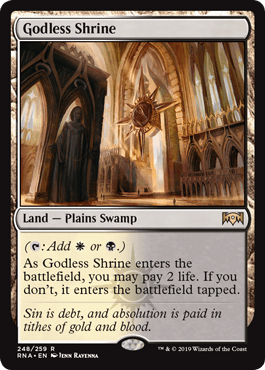
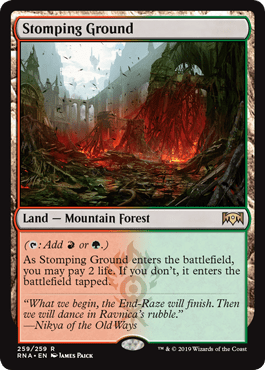
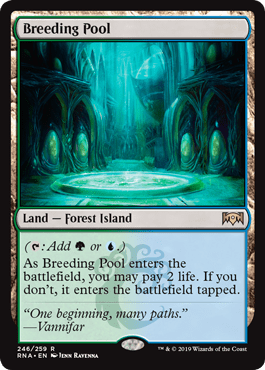
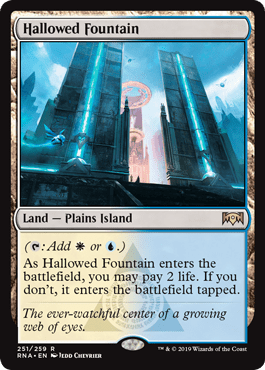
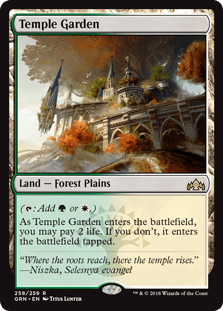
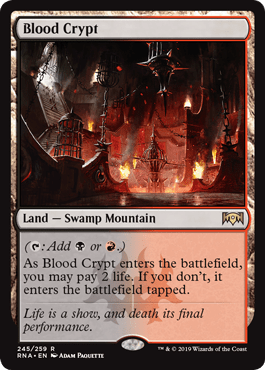
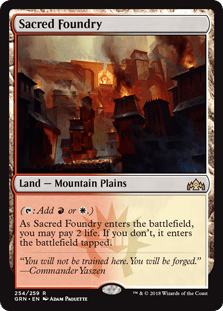
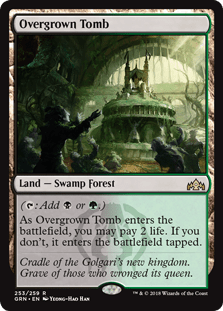
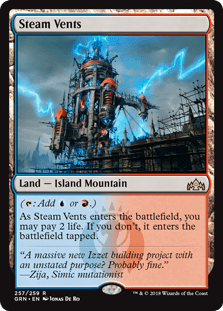
- Watery Grave
- Godless Shrine
- Stomping Ground
- Breeding Pool
- Hallowed Fountain
- Temple Garden
- Blood Crypt
- Sacred Foundry
- Overgrown Tomb
- Steam Vents
The complete lack of downside of the original duals created a power imbalance. Many iterations on the original duals were printed over time, but shocklands have taken over as the go-to versions in Standard, Pioneer, Commander, and Modern when legal.
Shocks act with all the same abilities as duals except that they enter tapped unless their controller pays two life. Named for this Shock effect, they offer mana fixing at an appreciable cost. When paired with fetches, decks can play a wide array of colors but can take between three and ten damage over the course of a game.
Shocklands are more restricting than the original duals but still powerful enough to demand play.
Fast Lands
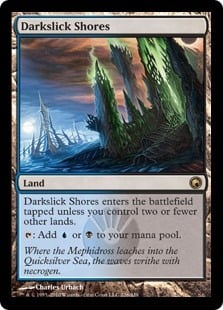



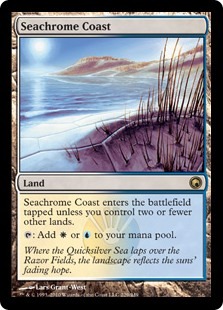
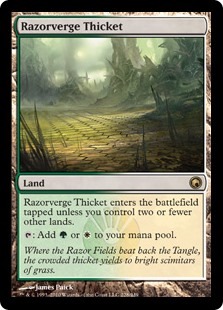

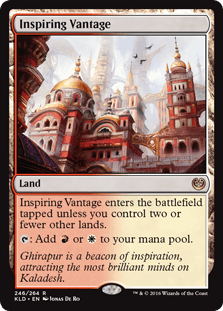


- Darkslick Shores
- Concealed Courtyard
- Copperline Gorge
- Botanical Sanctum
- Seachrome Coast
- Razorverge Thicket
- Blackcleave Cliffs
- Inspiring Vantage
- Blooming Marsh
- Spirebluff Canal
Named for their ability to come in untapped if they're one of the first three lands you control, fast lands help aggressive decks find their footing early. In the age of 2- and 3-color aggro decks, having access to duals on turn 1 and 2 can drastically change what your hand looks like.
Fast lands saw play in their respective Standard metas and still see play in Pioneer and Modern where legal. While they don't compete with some of the lands I mentioned above in older formats, they're still incredibly powerful in their ability to unlock quick and painless starts.
Horizon Lands
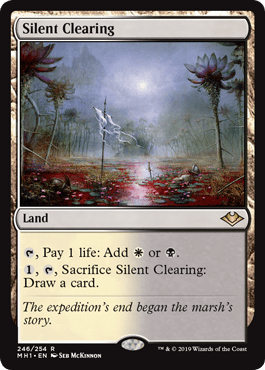
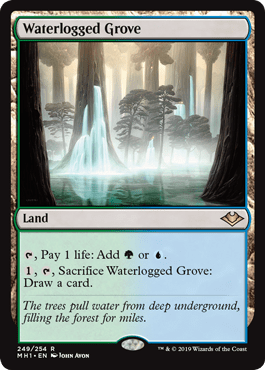
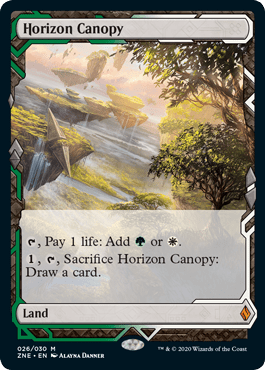
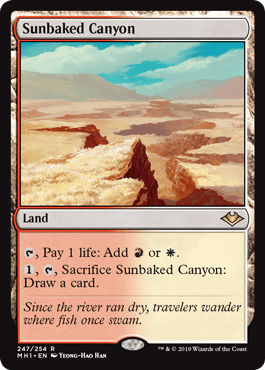
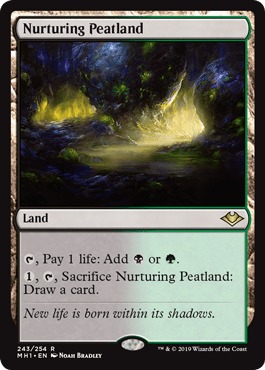
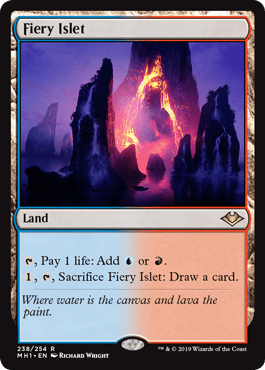
- Silent Clearing
- Waterlogged Grove
- Horizon Canopy
- Sunbaked Canyon
- Nurturing Peatland
- Fiery Islet
The first incomplete cycle, Horizon lands saw their debut with Horizon Canopy in Future Sight as a new take on pain lands that also act as card draw in the mid-to-late game. Canopy saw frequent play in Modern as a staple in decks like Abzan, Humans, and Hate Bears.
Several years later with the printing of Modern Horizons, five more color-pair versions of Canopy were printed. These immediately shifted the Modern format as decks like Izzet ( ) Phoenix, Izzet Prowess, Jund ( ), etc. had access to an effect that was previously limited to green and white decks.
Lots of aggro decks used having an extra dual to push their color requirements even further while cutting down on the chance of flooding by drawing cards once they had enough lands.
Pain Lands
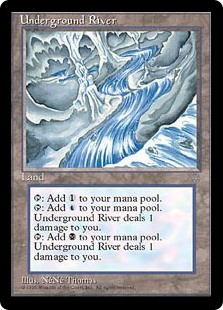
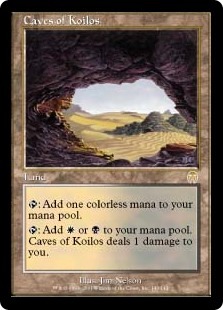
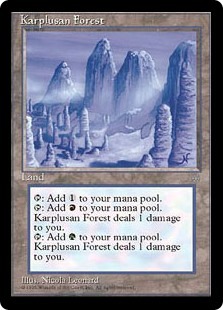
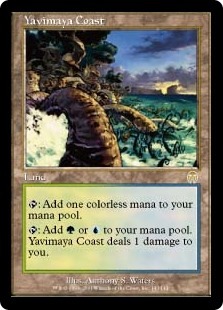

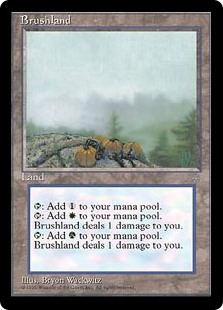
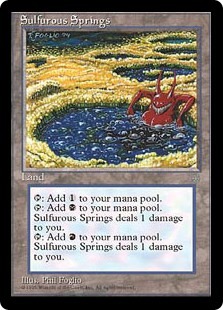
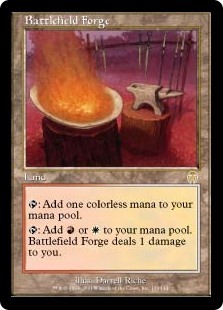
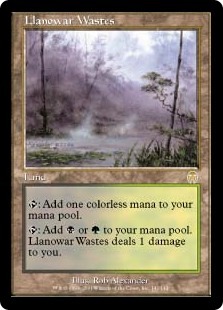
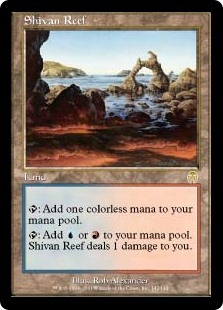
- Underground River
- Caves of Koilos
- Karplusan Forest
- Yavimaya Coast
- Adarkar Wastes
- Brushland
- Sulfurous Springs
- Battlefield Forge
- Llanowar Wastes
- Shivan Reef
Like the Horizon lands mentioned above, pain lands act as colorless lands for free or produce one mana of either of their colors at the cost of one life. While an untapped dual that only costs one life sounds fantastic, these can deal three or more damage the earlier they come down and the more color-intensive your deck.
The variable cost for these effects often contributes to why they see play in less powerful formats like Standard and Pioneer or as accessory lands in formats like Commander. The other main use for pain lands is in Modern Eldrazi decks that need a small amount of colored mana but also need colorless mana for their primary threats. Pain lands are invaluable in those style of decks.
Filter Lands
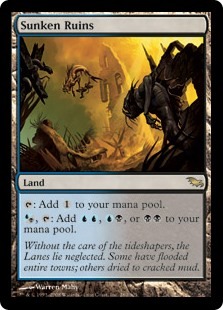
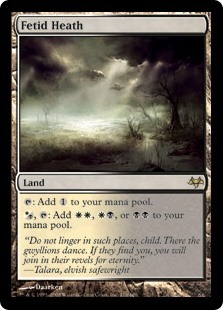

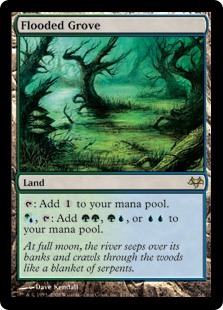
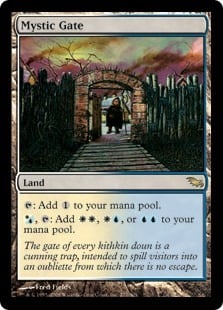
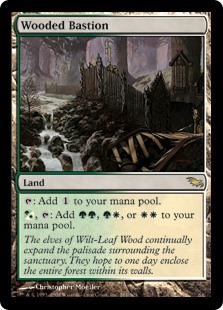
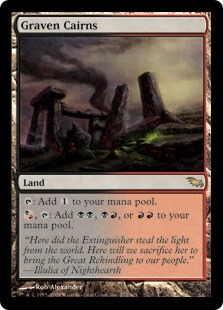
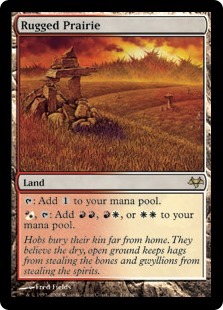
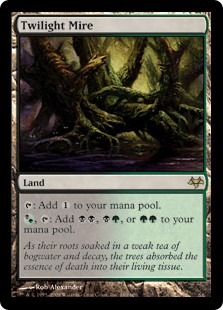

- Sunken Ruins
- Fetid Heath
- Fire-Lit Thicket
- Flooded Grove
- Mystic Gate
- Wooded Bastion
- Graven Cairns
- Rugged Prairie
- Twilight Mire
- Cascade Bluffs
Filter lands mostly see play in decks that really stretch color requirements. Kiki-Chord decks in Modern often used these cards to enable or cards alongside blue and white cards. Other examples of builds using these lands are 2-color EDH or Modern decks that need access to double pips of a specific color on early turns.
These lands are versatile but supplemental bandages to cover mana bases spread a bit too thin. These show up a lot less with the continued printing of newer duals, but they do the job better than any other set of lands when they are the right tool to fix a mana base.
Triomes
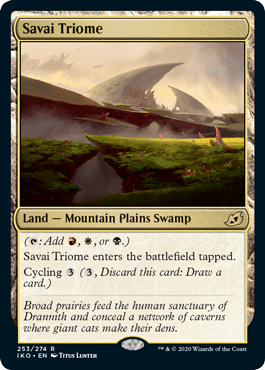
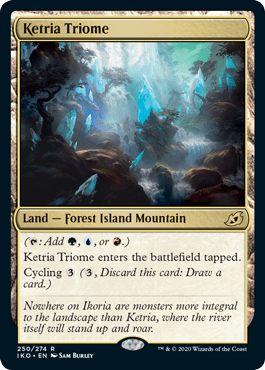
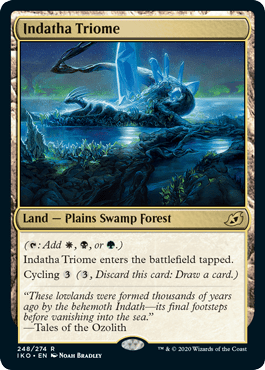
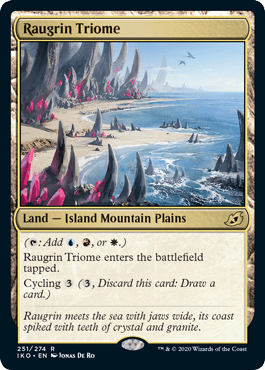
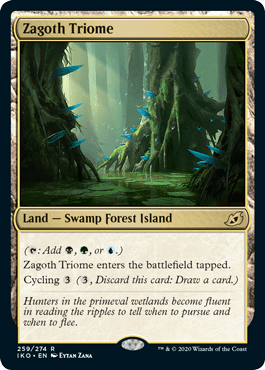
- Savai Triome
- Ketria Triome
- Indatha Triome
- Raugrin Triome
- Zagoth Triome
One of the latest takes on dual lands, "tri-lands" always come into play tapped but can tap for one of three colors as opposed to the traditional two. They can also cycle for three generic mana to help mitigate flooding in the mid-to-late game.
These lands see play in nearly every format thanks to their ability to come into play tapped on end step with a fetch land. While we'll hopefully see the rest of these Triomes in future sets, the ones we have now continue to have an impact across all the major formats.
Dual-Colored Creature Lands

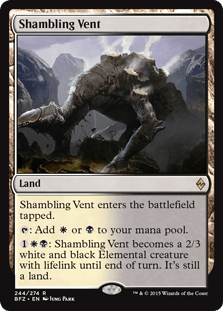
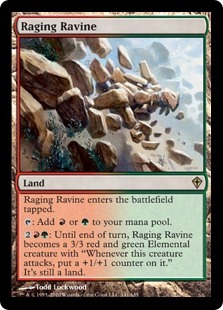
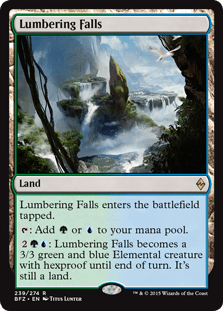
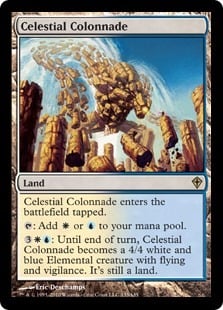
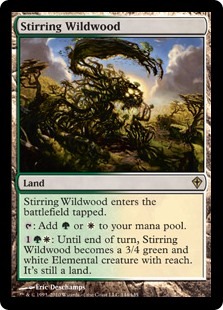
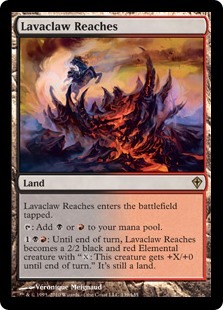
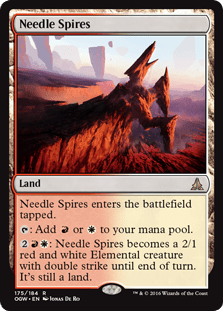
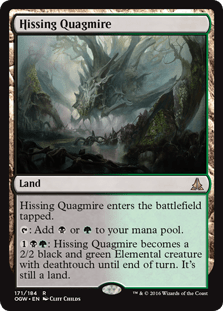
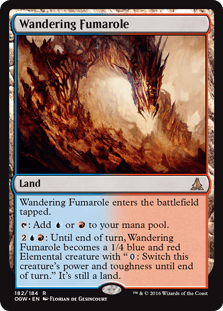
- Creeping Tar Pit
- Shambling Vent
- Raging Ravine
- Lumbering Falls
- Celestial Colonnade
- Stirring Wildwood
- Lavaclaw Reaches
- Needle Spires
- Hissing Quagmire
- Wandering Fumarole
The original set of five dual-colored creature lands from Worldwake had a massive impact on Standard and Modern with Celestial Colonnade and Raging Ravine specifically dominating the format for many years. The cycle was finished with the enemy-colored lands when we got Battle for Zendikar.
These lands also saw widespread play in Standard and Modern when they were first printed. While other creature lands have been printed since, they're mono-colored and don't help fix a deck's colors. These creature lands serve the dual purpose of fixing mana and acting as a threat, especially in midrange and control decks.
Best White Lands
Karakas

A lifetime staple of eternal formats, Karakas helps manage legendary threats and entire decks like Sneak and Show or Reanimator. It's also useful in protecting your own threats from interaction from opponents.
Serra's Sanctum
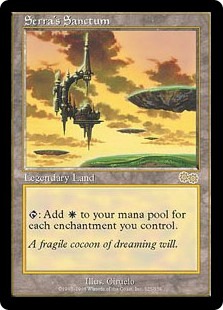
Urza's Saga produced a lot of truly broken cards and the cycle of "add a mana for each X you control" falls right in that category. Unbelievably efficient in enchantment-based prison decks, Serra's Sanctum routinely taps for the most mana at any EDH table.
Hall of Heliod's Generosity
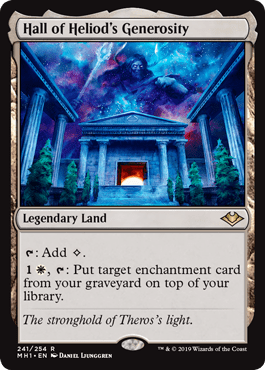
Another enchantment-themed card this time mirroring Academy Ruins by managing to recur key enchantments from the graveyard. Using Hall of Heliod's Generosity to rebuy crucial pieces that were destroyed can be the final nail in your opponent's coffin.
Windbrisk Heights
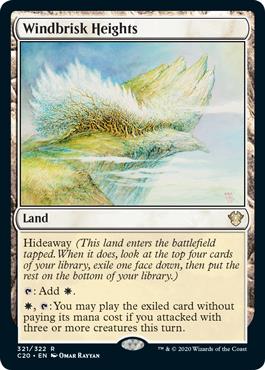
Hideaway lands are a format staple in EDH and every iteration of Cube. Windbrisk Heights allows small creature decks to power out abusive threats like Eldrazi or Anthem effects. A classic for any creature- or token-based EDH deck.
Flagstones of Trokair
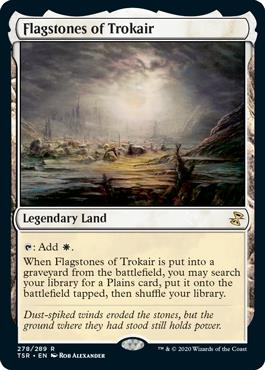
Flagstones of Trokair plays a crucial role in any Pox-style deck where symmetrical land sacrifice effects don't hurt the player with Flagstones. While not the most powerful ramp effect, being able to grab any Plains leads Flagstones to act as a form of fixing in decks that want to abuse its text.
Best Blue Lands
Tolarian Academy

Tolarian Academy is one of the most powerful lands of all time. This land was in the same cycle as Serra's Sanctum but counts artifacts rather than enchantments. Academy is banned in every format other than Vintage where it's restricted, and for good reason.
The amount of mana acceleration this card can cause breaks the balance of the game. While there aren't many places left to play Academy, be sure to enjoy the power level of this effect when you have the chance.
Hall of Storm Giants
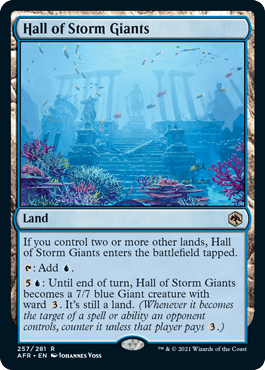
The premier creature land from Forgotten Realms, Hall of Storm Giants puts an immense amount of pressure on your opponents. From Standard to Pioneer to Commander, this card dominates as a huge clock that's very difficult to interact with given its ward 3 ability.
While the activation cost stops this from seeing much play outside of more recent formats, the card continues to impress every time it sees play.
Academy Ruins
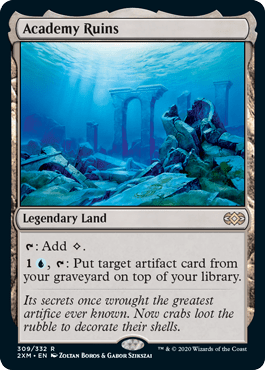
Academy Ruins has seen play as a lock-piece with Mindslaver in Modern Mono Blue Tron, it locks out players in Lantern Control, it periodically saw play in eternal formats to rebuy Batterskull during the Stoneblade days, and it certainly sees EDH play. Being able to recur key artifacts and pieces makes your opponent's interaction near meaningless and is an incredibly powerful effect.
Mystic Sanctuary

This common is banned in Modern after looping Cryptic Command in 4-color pile decks. Fetching an untapped land that ensures the card of your choice ends up on top of your library is an incredible effect.
Mystic Sanctuary acts as a regrowth on any instant or sorcery and can bury opponents in a single turn. While the requirement to play several Islands in your deck can limit your options, cards like Triomes, duals, and shocklands make it much easier to achieve without sacrificing any power level.
Tolaria West
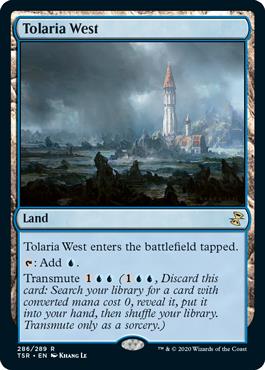
Transmute allows for a wide range of options. Tolaria West is synonymous with Amulet Titan in Modern. Fetching Engineered Explosives, Walking Ballista, or Summoner's Pact has helped top tier players dominate with this deck for years now.
Tolaria also sees plenty of play in EDH where the options expand even further for what lands and 0-cost cards you can easily find. While the deckbuilding adaptations are endless with a transmute card, finding pacts tends to shoehorn this card into unfair strategies, and that gives it an important role in combo decks.
Best Black Lands
Urborg, Tomb of Yawgmoth
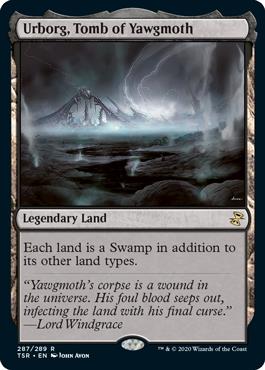
Mana fixing is an important element to the value of lands, but Urborg, Tomb of Yawgmoth allows for all the colorless value lands in your deck to have no drawback. Often seen every time there's a mono black deck in Pioneer or Modern or a Pox-style deck in Legacy, this land is a classic staple.
Fixing your opponent's mana and turning off their pain lands can be a significant drawback, but being able to make your black decks stronger is a fair tradeoff.
Cabal Coffers
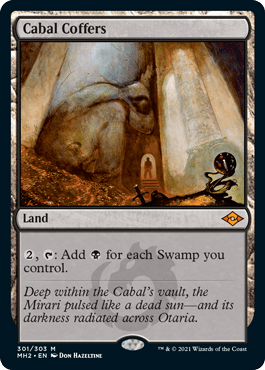
Another staple of heavy Swamp decks, Cabal Coffers can nearly double your mana in mono-black decks. Much like the Urza's Saga lands above, rapidly accelerating your mana without messing with your primary gameplan often allows decks with this card to end the game when it hits the battlefield, even if the game goes on another turn or two.
Phyrexian Tower
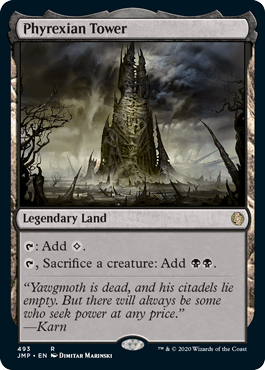
A key element of decks like Nic Fit in Legacy and all sacrifice or combo ramp decks in Historic, Phyrexian Tower gives decks a free sacrifice outlet and can ramp into punishing spells early. Paired with the death triggers often found in black decks, Tower can act as ramp, a combo piece, or just a 1-turn burst of acceleration to push through an unexpected threat.
Bojuka Bog
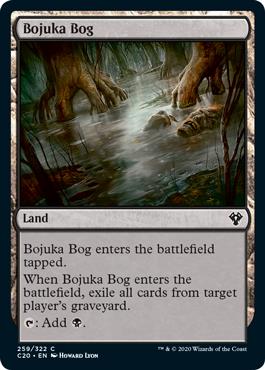
The premier form of mana-less graveyard hate in every format. Need a way to attack decks like Dredge or just need to slow down a value engine like Phoenix? Well, Bojuka Bog does that for free and still taps for mana afterwards.
Famously found in decks like Amulet Titan and Lands, Bog is also an EDH staple silver bullet to manage the overly unfair decks. This is a tool needed to manage the things that are truly degenerate.
Best Red Lands
Valakut, the Molten Pinnacle
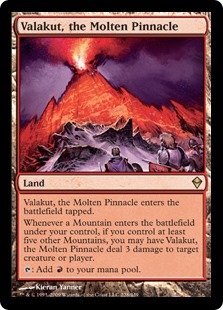
A win condition for land-based decks since it was printed in Standard. A staple of Modern decks, especially with the printing of Dryad of the Ilysian Grove to bolster the deck's ability to kill out of nowhere.
While it's harder to make Valakut, the Molten Pinnacle work in a format like Commander, having free repeated Lightning Bolts can help you beat most creature decks.
Dwarven Mine

With the printing of Throne of Eldraine, a lot of cards become overt problems. But Dwarven Mine lurked under the surface in Pioneer and Modern where decks could use Transmogrify effects to cheat out impactful threats cheaply.
Since its printing, Mine has featured in plenty of 5-0 decklists, won Modern and Pioneer Challenges, and placed players in the top 8 of PTQs. One of the most powerful cards left legal from Eldraine.
Best Green Lands
Gaea's Cradle
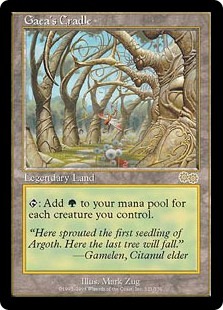
Another Urza's Saga land breaking things in half. Gaea's Cradle has become one of the most expensive Legacy staples in decks like Elves and in any creature-based deck in EDH. If you're playing a creature-heavy green deck, especially with cards like Dryad Arbor, this is without fail the land for you.
Yavimaya, Cradle of Growth
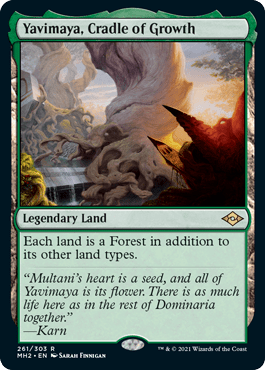
All the same notes apply here as with Urborg, Tomb of Yawgmoth, except Yavimaya, Cradle of Growth saves decks like Tron and Eldrazi Stompy from Void Mirror ending their ability to cast cards. Once again, free fixing on all of your non-green sources is an incredibly powerful effect.
Mosswort Bridge

A Commander staple, Mosswort Bridge allows any green creature deck to cheat out large threats or expensive spells very early in the game. While none of the Hideaway lands see much play outside of Cube and EDH, their power level keeps them relevant as one of the most reliable ways to cheat large threats.
Castle Garenbrig
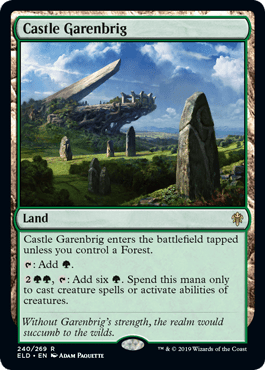
One of the strongest green enablers printed in the past few years. Castle Garenbrig gave Titan decks another way to speed out a titan in Modern. It also gave Commander and Pioneer decks faster access to six mana, which tends to be a breaking point for powerful creatures in green.
While several additions to the Titan decks all came in tandem, Garenbrig allowed for the most consistent early Titans since Summer Bloom.
Best Multicolor Lands
Conditional Lands

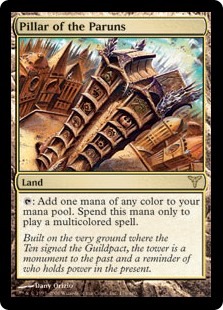
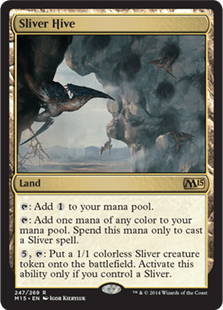
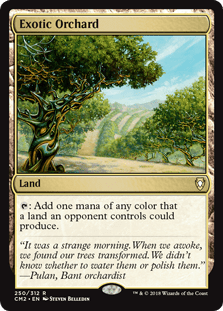


- Cavern of Souls
- Pillar of the Paruns
- Sliver Hive
- Exotic Orchard
- Reflecting Pool
- Ancient Ziggurat
These lands are conditionally 5-color lands. They often give a specific benefit like "can't be countered" or "can produce one mana of any color for a specific subtype of cards."
While multicolor lands aren't always fully capable of freely casting every spell, there aren't more powerful lands for the cards that meet their conditions. Especially in constructed formats where you can build your deck around these conditions, like with Humans or 5-color Niv.
Consistent Lands
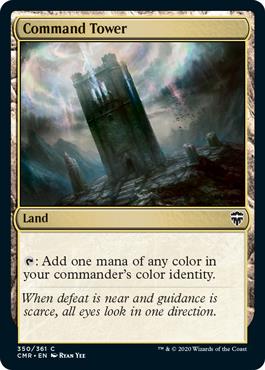
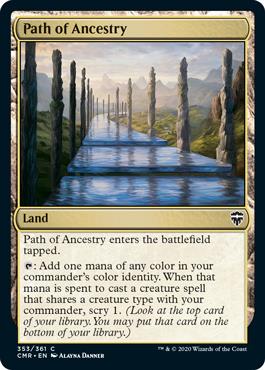

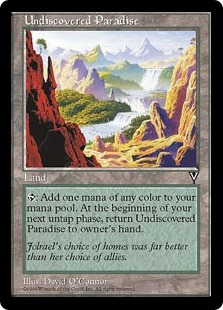
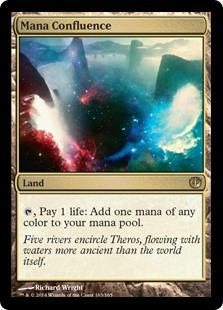
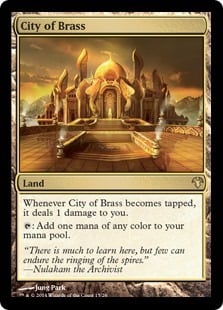
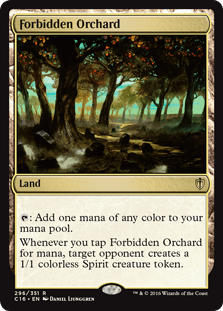
- Command Tower
- Path of Ancestry
- Cascading Cataracts
- Undiscovered Paradise
- Mana Confluence
- City of Brass
- Forbidden Orchard
These multicolor lands always produce the same colors but can produce up to all five colors. Some of these are dependent on your Commander but most just have a small life total or tempo tax to make sure you can cast your spells.
These lands are fan favorites in EDH as the light life tax is even less punishing when starting at 40 life. Even in Modern, color-intensive decks that don't work around a single subtype often use cards like Mana Confluence to smooth out their needs.
Best Colorless Lands
Multiple-Mana Producers
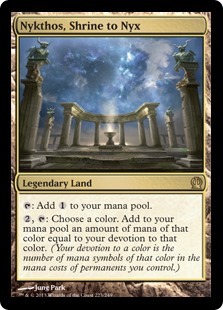
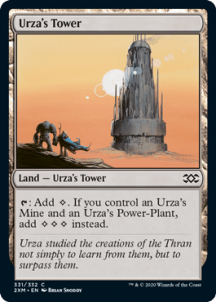
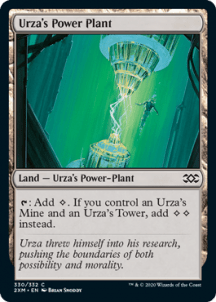
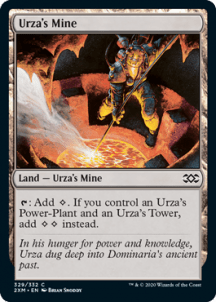
These lands all conditionally produce more than one mana and can easily accelerate you into a mana advantage. Much like the Urza's Saga lands I already mentioned, cards like Nykthos, Shrine to Nyx or the Tron lands (Urza's Tower, Urza's Power Plant, and Urza's Mine) that generate massive mana advantages can win the game by themselves.
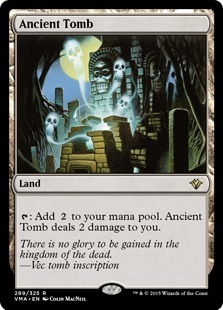
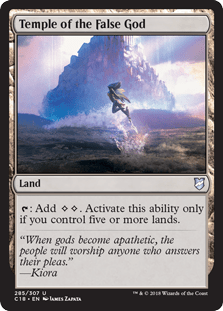

Ancient Tomb, Temple of the False God, and City of Traitors help skip ahead on mana for minimal cost, especially if you only need to use them once or twice to win the game.
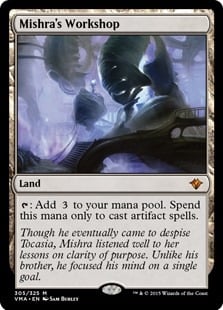
Mishra's Workshop has a small restriction of only working on artifacts but getting three mana from a single land is something most decks can't compete against, even on turn 1. This land is the foundation of several Vintage decks and it's easy to see how it can snowball a game.
Creature Lands
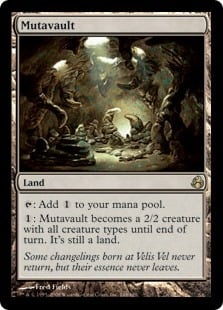


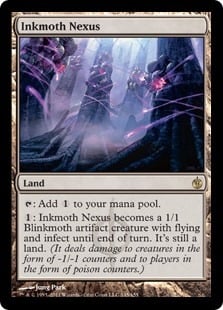
These lands either activate to become a creature or act as an alternate stream of threats from your lands. Cards like Mutavault, Mishra's Factory, Faceless Haven, and Inkmoth Nexus animate and attack your opponents as wrath-resilient threats.
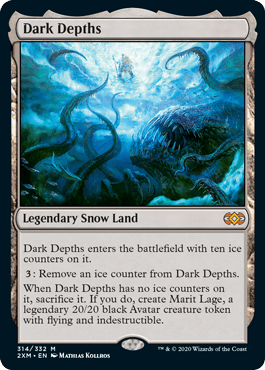
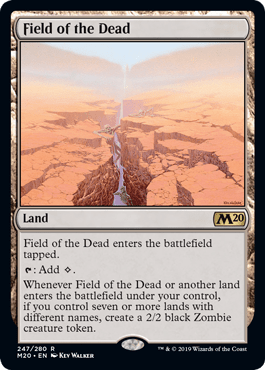

Dark Depths, Field of the Dead, and Urza's Saga create creature tokens that can control the game. Field has proven too powerful for several formats and Depths paired with Thespian's Stage or other ways to remove counters proved too powerful for Modern.
Mana Denial

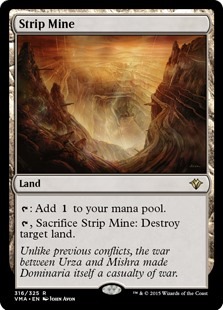
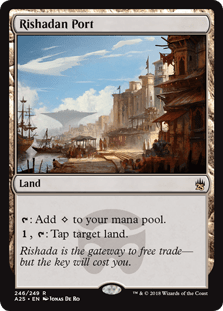
Wasteland, Strip Mine, and Rishadan Port work to limit your opponent's mana base and kill their important lands. Lands like Gaea's Cradle will singlehandedly take over the game without access to these cards. Mana decks also pair these lands with things like Crucible of Worlds to lock your opponent out of the game.
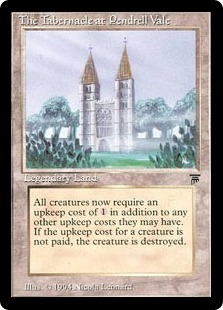
An incredibly effective mana tax card for any creature decks. The Tabernacle at Pendrell Vale is a staple in Legacy to manage low-to-the-ground creature decks like Delver.

The tenth member of the Power Nine. Library of Alexandria takes over games through sheer card advantage. If Library comes down on turn 1, there are very few decks that can win without directly answering your land.
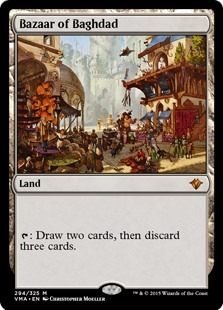
Bazaar of Baghdad is a Vintage and Cube all-star and the most efficient land for dumping your hand into the graveyard. Reanimator and Dredge strategies love this over any other land ever printed.

A useful ability to copy any land you need, but Thespian's Stage is primarily used to combo with Dark Depths and create an instant-speed 20/20 indestructible creature to end the game. This land can notably copy basic lands to avoid certain types of land destruction like Wasteland.
Best Utility Lands
Rogue's Passage
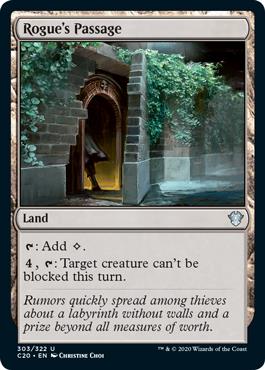
Rogue's Passage saw light play in devotion mirrors to sneak through large creatures. But sneaking through commanders or large creatures can end games in a format like EDH.
Buried Ruin

One-time artifact recursion is a strong effect on a land. But Buried Ruin can take over a game in a format like EDH where you can reuse lands with Crucible of Worlds, Life from the Loam, or Ramunap Excavator.
Scavenger Grounds
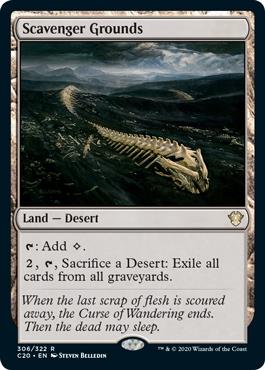
Scavenger Grounds is a main-deck piece of graveyard hate for Eldrazi decks in several formats and was a major player in its Standard format. Selective graveyard hate, especially if it dodges artifact or enchantment removal, helps defend against degenerate reanimator strategies.
Best Legendary Lands
Inventors' Fair
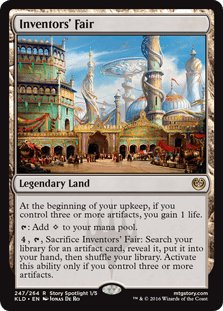
A hallmark of Lantern Control and other artifact centric decks, Inventors' Fair helps stabilize against aggressive strategies and find lock pieces or combo elements. Decks with important artifacts have used Fair to great effect since its printing, including winning a Pro Tour.
Gemstone Caverns
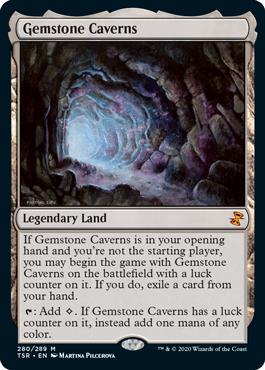
One of the great RNG cards left in Magic, Gemstone Caverns allows you to gain a tempo advantage in exchange for card disadvantage. You only need a specific set of resources in most formats where this card sees play, so sacrificing a spare card to combo a turn earlier can change the texture of the game.
Geier Reach Sanitarium
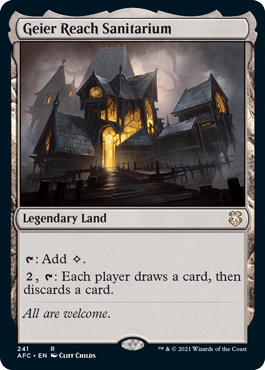
Played in combination with Narset, Parter of Veils or Leovold, Emissary of Trest, Geier Reach Sanitarium can lock opponents out from ever casting non-instants by activating its ability on your draw step. This combo periodically shows up in Modern Azorius ( ) control and in formats like Tiny Leaders and Commander. It can also help filter through cards while fueling the graveyard when you don't have the full lock.
Miren, the Moaning Well
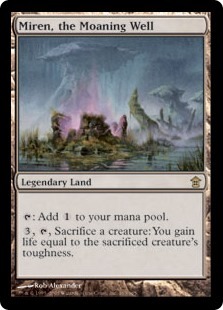
While there are lots of sacrifice lands in formats like Commander, Miren, the Moaning Well allows for large lifegain to mitigate an offense from opponents. Decks that want cheap sacrifice choose something like High Market but Miren works better than almost any land available in decks where lifegain matters or can create larger creatures.
Best Basic Lands
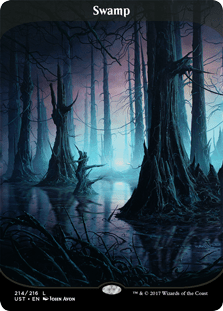
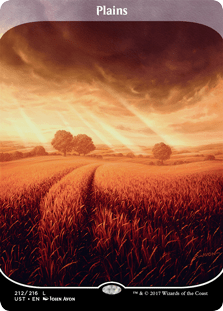
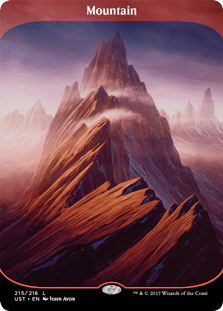

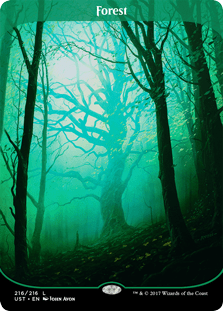
Do you go with the most expensive basic lands? Do you choose full art lands? I personally go with the beautiful Unstable set of basics. But there's no wrong answer for best basic lands! Let me know in the comments what basic lands you sleeve up for events.
Wrap Up

Forbidden Orchard | Illustration by Daniel Ljunggren
That's all there is to say about the best lands in Magic. What are your thoughts on this list? Any lands you think I missed that need to be mentioned? Let me know below or find us over on Twitter if that's more your things.
That's all from me for today. Have a good one, and I'll see you next time!
Follow Draftsim for awesome articles and set updates:Source: https://draftsim.com/best-lands-mtg/
0 Response to "Mtg Lands That Produce Green or Blue Mana"
Post a Comment